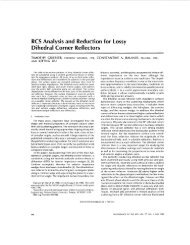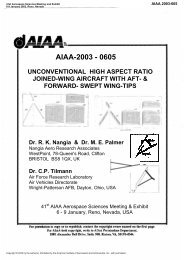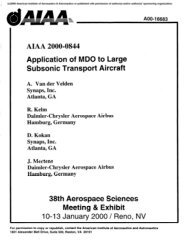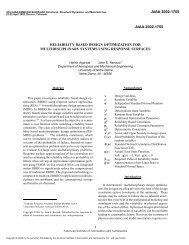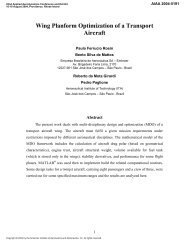Refinement and analysis of concept
Refinement and analysis of concept
Refinement and analysis of concept
You also want an ePaper? Increase the reach of your titles
YUMPU automatically turns print PDFs into web optimized ePapers that Google loves.
<strong>Refinement</strong> <strong>and</strong> Analysis<br />
<strong>of</strong> Design Concept<br />
Moving into the Stage <strong>of</strong> Preliminary Design
1. Specification<br />
2. Configuration A<br />
3. Flight regime / Powerplant<br />
4. Fuselage layout<br />
5. Wing configuration 1<br />
6. Lift, drag, mass<br />
7. performance<br />
8. Stage one optimization:T/Mg, mg/S<br />
8. Stage two optimization: referee design<br />
8. Configuration comparison<br />
9. Concept <strong>analysis</strong><br />
Road Map<br />
航空宇航学院<br />
Configuration B Configuration C<br />
Wing configuration 2 Wing configuration 3<br />
Aircraft Conceptual Design
Introduction<br />
航空宇航学院<br />
• We just completed the <strong>concept</strong>ual design synthesis<br />
• Now moving on to the stage <strong>of</strong> preliminary design<br />
– <strong>Refinement</strong>s<br />
• More detail parameters <strong>of</strong> the configuration<br />
• More detail <strong>and</strong> precise arrangements <strong>of</strong> the layout<br />
– Analysis<br />
• Verifying the design <strong>concept</strong> using more precise models<br />
– Optimization<br />
• Searching a optimum design with more detail parameters <strong>of</strong> the<br />
configuration using more precise models<br />
Aircraft Conceptual Design
<strong>Refinement</strong>s<br />
• Powerplant<br />
• Aerodynamic Configuration<br />
• Structure Layout<br />
• L<strong>and</strong>ing Gear<br />
• Fuselage Layout
航空宇航学院<br />
<strong>Refinement</strong>s <strong>of</strong> Powerplant<br />
• More accurate engine data<br />
– Mass data:<br />
– Size data:<br />
– Performance data: Variation <strong>of</strong> thrust <strong>and</strong> fuel consumption as<br />
function <strong>of</strong> flight speed, altitude <strong>and</strong> engine setting<br />
• How to get the data<br />
– From the engine manufactures<br />
– Using the more precise model <strong>of</strong> the engine based the engine<br />
design method<br />
• Powerplant Location<br />
– The development <strong>of</strong> the design <strong>concept</strong> now enables the question<br />
<strong>of</strong> powerplant location to be considered more precisely.<br />
Aircraft Conceptual Design
Powerplant Location<br />
• Versatility <strong>and</strong> access:<br />
航空宇航学院<br />
– As a general rule engines mounted in pods or nacelles on the<br />
outside <strong>of</strong> the aircraft are more versatile than those buried within<br />
the airframe.<br />
– It is usually possible to accommodate different engines without<br />
too much difficulty, thereby more readily h<strong>and</strong>ling upgrades or<br />
specific customer requirements.<br />
– Podded <strong>and</strong> nacelle-mounted engines are also preferable for<br />
maintenance since access is generally more direct <strong>and</strong> need not<br />
involve significant structural penalties.<br />
– Also air intakes <strong>and</strong> exhausts are usually shorter <strong>and</strong> can be<br />
more efficient.<br />
Aircraft Conceptual Design
Powerplant Location<br />
• Installation clearance<br />
航空宇航学院<br />
– As the engine dimensions are defined it is necessary to check<br />
installation clearances, such as propeller tip spacing from adjacent<br />
structure or the ground <strong>and</strong> under-wing nacelle ground clearance on<br />
a low wing aircraft.<br />
Aircraft Conceptual Design
• Safety<br />
Powerplant Location<br />
航空宇航学院<br />
– The powerplants must be positioned so that in emergency<br />
situations they do not pose a threat to the occupants <strong>of</strong> the<br />
aircraft or other safety critical components.<br />
– The major concerns are the consequences <strong>of</strong> an engine<br />
becoming detached during an emergency alighting situation<br />
or the failure <strong>of</strong> rotating components such as fan <strong>and</strong> turbine<br />
blades or discs <strong>and</strong> propeller blades.<br />
– The engines must be located such that these component<br />
failures do not present a hazard to other engines, primary<br />
structures or vital systems.<br />
Aircraft Conceptual Design
Powerplant Location<br />
• Acoustic considerations<br />
航空宇航学院<br />
– The further aft on an aircraft the engine is located the less is the<br />
noise impact upon the occupants, but this is not usually a major<br />
consideration.<br />
– Some engine positions, for example those above the wing or<br />
fuselage, reduce the noise as perceived at the ground but at the<br />
expense <strong>of</strong> powerplant efficiency.<br />
– Acoustic fatigue damage to airframe components located near the<br />
exhaust is likely to be a more important consideration.<br />
– It is especially significant for engines which employ reheat when the<br />
exhaust outlets should be behind all major airframe components.<br />
Aircraft Conceptual Design
Powerplant Location<br />
• Stability <strong>and</strong> control<br />
航空宇航学院<br />
– Lateral stability <strong>and</strong> control requirements for a multi-engined<br />
aircraft may well be dominated by the need to maintain the<br />
path <strong>of</strong> the aircraft subsequent to the failure <strong>of</strong> the most<br />
critical engine.<br />
– From this point <strong>of</strong> view wing-located powerplants should be<br />
as far inboard as allowed by other considerations.<br />
Aircraft Conceptual Design
Powerplant Location<br />
• Powerplant/airframe effciency<br />
航空宇航学院<br />
– This <strong>of</strong>ten means a compromise between engine requirements<br />
<strong>and</strong> those <strong>of</strong> the overall aerodynamics.<br />
– For example:<br />
• it may be desirable on a short take-<strong>of</strong>f propeller driven aircraft to space the<br />
engines across the wing to enhance slipstream effect upon low speed lift.<br />
• Ground clearance may suggest that large diameter power units should be<br />
mounted over the top <strong>of</strong> the wing but this can lead to a considerable loss <strong>of</strong><br />
efficiency <strong>of</strong> lift development.<br />
• In the case <strong>of</strong> buried engines the intake arrangements may have a significant<br />
effect upon powerplant efficiency <strong>and</strong> must be given careful consideration,<br />
Aircraft Conceptual Design
• Introduction<br />
<strong>Refinement</strong> <strong>of</strong> wing<br />
航空宇航学院<br />
– The <strong>analysis</strong> <strong>of</strong> the lifting characteristics <strong>of</strong> the wing dem<strong>and</strong>s a<br />
more specific consideration <strong>of</strong> both the basic aer<strong>of</strong>oil section <strong>and</strong><br />
the geometry <strong>of</strong> the high lift devices than was possible at the<br />
<strong>concept</strong>ual design stage<br />
• Airfoil selection <strong>and</strong> design<br />
– The output <strong>of</strong> the parametric <strong>analysis</strong> includes some aer<strong>of</strong>oil detail,<br />
such as the root thickness to chord ratio <strong>and</strong> the desired critical<br />
Mach number characteristics.<br />
– This information may be used in the selection <strong>of</strong> a suitable aer<strong>of</strong>oil.<br />
– The airfoil design <strong>and</strong> optimization will be introduced later.<br />
Aircraft Conceptual Design
• High lift device<br />
<strong>Refinement</strong> <strong>of</strong> wing<br />
– Leading edge high lift devices<br />
航空宇航学院<br />
• While leading edge high lift devices may be located across the greater part<br />
<strong>of</strong> the wing span, it may be necessary to accept some interruption, as for<br />
example in the region <strong>of</strong> wing-located powerplants.<br />
• Such effects should be minimised <strong>and</strong> carefully considered as the details <strong>of</strong><br />
the design are established.<br />
Aircraft Conceptual Design
<strong>Refinement</strong> <strong>of</strong> wing<br />
– The trailing edge high lift devices<br />
航空宇航学院<br />
• Generally the spanwise extent <strong>of</strong> the trailing edge high lift devices is limited<br />
by the need to provide ailerons for roll control although in some special<br />
circumstances these may be "drooped" to augment the lift.<br />
• Outboard ailerons are usually needed for low speed roll control <strong>and</strong> typically<br />
occupy 20-25% <strong>of</strong> the wing semi-span.<br />
Aircraft Conceptual Design
航空宇航学院<br />
<strong>Refinement</strong> <strong>of</strong> aerodynamics design<br />
• Control/stabilizer surface<br />
– Outer ailerons on high aspect ratio sweptback wings may<br />
introduce aeroelastic difficulties when used at high speed, <strong>and</strong> to<br />
overcome this problem alternative high speed roll control may be<br />
provided in the form <strong>of</strong> inboard ailerons or differential longitudinal<br />
controls such as tailerons.<br />
– In the case <strong>of</strong> inboard ailerons there will be an effect upon the<br />
extent <strong>of</strong> the trailing edge flaps although this may be minimised<br />
by locating the controls immediately behind powerplants.<br />
– Within some limits the effectiveness <strong>of</strong> trailing edge devices may<br />
be adjusted by variation <strong>of</strong> their chordwise extent.<br />
Aircraft Conceptual Design
航空宇航学院<br />
<strong>Refinement</strong> <strong>of</strong> control <strong>and</strong> stabiliser surfaces<br />
• The design <strong>of</strong> the control <strong>and</strong> stabiliser surfaces<br />
requires ensuring that there is:<br />
– Ability to provide the forces/moments needed to maintain the<br />
trim <strong>of</strong> the aircraft in all flight conditions.<br />
– Ability to provide control forces/moments to meet prescribed<br />
h<strong>and</strong>ling criteria, including situations in which a partial failure<br />
has occurred.<br />
– Stability in both the static <strong>and</strong> dynamic sense, or alternatively<br />
acceptable artificial damping or stability in all critical modes.<br />
Aircraft Conceptual Design
航空宇航学院<br />
<strong>Refinement</strong> <strong>of</strong> control <strong>and</strong> stabiliser surfaces<br />
• The design <strong>of</strong> the control <strong>and</strong> stabiliser surfaces is<br />
complex because <strong>of</strong> the number <strong>of</strong> separate conditions<br />
which have to be met.<br />
• Some simplifications may be made to facilitate the<br />
process during initial design work<br />
• We have presented the design methods for the<br />
longitudinal <strong>and</strong> lateral requirements respectively.<br />
• The output from these methods may then be used for<br />
a full <strong>analysis</strong>.<br />
Aircraft Conceptual Design
Structure<br />
航空宇航学院<br />
• The overall layout <strong>of</strong> the aircraft must be compatible with<br />
an efficient structure<br />
• The aerodynamic configuration must not be such as to<br />
imply an unacceptable high structure weight.<br />
• Wing structure layout<br />
– Referring to the course “ Design <strong>of</strong> Aircraft Structure”<br />
• Fuselage structure layout<br />
– Referring to the course “ Design <strong>of</strong> Aircraft Structure”<br />
Aircraft Conceptual Design
Wing structure layout<br />
航空宇航学院<br />
• Sometimes the spanwise bending <strong>and</strong> torsion requirements may<br />
be met by a single beam or spar located near to the maximum<br />
chordwise depth <strong>of</strong> the aer<strong>of</strong>oil <strong>and</strong> associated with a shear<br />
carrying leading edge, or 'D' nose, terminating at the spar.<br />
• More usually there are two or more spars located across the<br />
chord, <strong>and</strong> together with the upper <strong>and</strong> lower covers between<br />
their chordwise extremities they form a box beam which also<br />
meets the torsion requirement.<br />
• The forward <strong>and</strong> aft extremities <strong>of</strong> this beam are determined by<br />
the auxiliary lifting surfaces <strong>and</strong> ailerons.<br />
• The rearmost spar is <strong>of</strong>ten located at 60-70% <strong>of</strong> the chord,<br />
leaving room for the trailing edge surfaces<br />
Aircraft Conceptual Design
Wing structure layout<br />
航空宇航学院<br />
• The box beam also conveniently acts as integral tankage for the fuel<br />
<strong>and</strong> access panels are required for inspection purposes.<br />
• For moderate to high aspect ratio wings the box beam should be<br />
continuous across the whole span.<br />
• Large cutouts for such items as l<strong>and</strong>ing gear stowage should be<br />
outside its boundaries.<br />
• When the powerplant is buried within the fuselage <strong>and</strong> the wing is <strong>of</strong><br />
relatively low aspect ratio, it is <strong>of</strong>ten necessary to use several spanwise<br />
spars <strong>and</strong> to pass the bending loads round the fuselage by means <strong>of</strong> a<br />
series <strong>of</strong> ring frames to which the spars are connected.<br />
Aircraft Conceptual Design
航空宇航学院<br />
An example <strong>of</strong> structure layout<br />
Aircraft Conceptual Design
航空宇航学院<br />
<strong>Refinement</strong> <strong>of</strong> L<strong>and</strong>ing Gear<br />
• The main points to be investigated are<br />
– Overall layout geometry, including the number <strong>of</strong> main gear units<br />
– Number <strong>and</strong> size <strong>of</strong> the wheels/tyres<br />
– Location <strong>of</strong> suitable stowage volume<br />
– Location <strong>of</strong> suitable load attachment points.<br />
• Clearly these latter two issues are closely related to the<br />
layout <strong>of</strong> the structural members.<br />
See Addendum 1 for more detail<br />
Aircraft Conceptual Design
Fuselage Layout<br />
航空宇航学院<br />
• A more precise <strong>and</strong> detailed layout <strong>of</strong> the fuselage may<br />
now be undertaken.<br />
– Influence <strong>of</strong> the wing junction with the fuselage<br />
– L<strong>and</strong>ing gear attachment <strong>and</strong> stowage<br />
– Layout <strong>of</strong> the cockpit region, windscreen geometry, etc.<br />
– Detail <strong>of</strong> the powerplant installation<br />
– Payload detail<br />
• Doors,windows<br />
• Freight loading access <strong>and</strong> doors<br />
– Special detail considerations<br />
With an aid <strong>of</strong> CAD s<strong>of</strong>tware<br />
Aircraft Conceptual Design
Now, we embark on <strong>analysis</strong> <strong>of</strong> the more<br />
detail design using more precise models<br />
• Mass prediction<br />
• Aerodynamics <strong>analysis</strong><br />
• Structure <strong>analysis</strong><br />
• Performance <strong>analysis</strong><br />
• Stability <strong>and</strong> control <strong>analysis</strong><br />
• Cost
航空宇航学院<br />
Mass Prediction Techniques<br />
• Empirical comparisons<br />
– Predictions by direct comparison with other similar design<br />
• Empirical formulae<br />
– Derived by a statistical <strong>analysis</strong> <strong>of</strong> available information from<br />
many aircraft (see chapter 6 )<br />
• Theoretically derived formulae<br />
– Based on a simplified design <strong>of</strong> the component<br />
– See Addendum 4<br />
• Detail estimation method<br />
– Need information <strong>of</strong> the detailed component<br />
Aircraft Conceptual Design
Aerodynamic Analysis<br />
航空宇航学院<br />
• The different levels <strong>of</strong> the <strong>analysis</strong> models<br />
– Theoretical method<br />
• Aerodynamic theory + empirical data (past experience)<br />
– Numerical methods<br />
• Vortex lattice method<br />
• Panel Method<br />
• Computational Fluid Dynamics (CFD)<br />
– Experimental method<br />
• Wind tunnel tests<br />
Aircraft Conceptual Design
Aerodynamic Analysis<br />
Theoretical + empirical method<br />
C C KC<br />
D<br />
D0<br />
L<br />
0.<br />
e 1. 78(<br />
1<br />
0.<br />
045<br />
2<br />
68<br />
) <br />
k<br />
0.<br />
64<br />
1<br />
<br />
<br />
n<br />
( C S )<br />
f , i wet , i<br />
i1<br />
C <br />
C C C<br />
D0<br />
D,<br />
misc D,<br />
漏,凸 D,<br />
波<br />
Vortex lattice method<br />
S<br />
e<br />
(unswept)<br />
航空宇航学院<br />
Wind tunnel test<br />
Panel method CFD<br />
Aircraft Conceptual Design
Structure Analysis<br />
• Beam theory<br />
– Refer to the course “Structure Mechanics”<br />
• Finite Element Method (FEM )<br />
航空宇航学院<br />
Aircraft Conceptual Design
Performance Analysis<br />
航空宇航学院<br />
• Predicate a precise performance using the<br />
following upgraded information<br />
– Engine data<br />
– More precise lift <strong>and</strong> drag data<br />
– More precise mass data<br />
Performance<br />
Powerplant aerodynamics Mass<br />
Aircraft Conceptual Design
Stability <strong>and</strong> Control Analysis<br />
• Theoretical + empirical method<br />
– Referring to textbook on “Flight Dynamics”<br />
– DatCom s<strong>of</strong>tware<br />
– AAA s<strong>of</strong>tware<br />
• Numerical method<br />
– Vortex lattice<br />
– Panel method<br />
– CFD<br />
• Wind tunnel test<br />
航空宇航学院<br />
Aircraft Conceptual Design
Cost Analysis<br />
航空宇航学院<br />
Cost estimation should base on a<br />
comparative rather than absolute value<br />
Aircraft Conceptual Design
航空宇航学院<br />
Different Cost Meanings<br />
• Selling cost<br />
– driven by market forces<br />
• First cost<br />
• Operating costs<br />
• Lift cycle costs<br />
Aircraft Conceptual Design
• What is first cost<br />
First cost<br />
航空宇航学院<br />
– The sum <strong>of</strong> the actual cost <strong>of</strong> making the aircraft <strong>and</strong> the<br />
share <strong>of</strong> the development costs allocated to it.<br />
• First cost is difficult to be predicted at the aircraft<br />
<strong>concept</strong>ual design<br />
– Simple cost models are usually based on aircraft volume<br />
<strong>and</strong>/or mass <strong>and</strong> derived empirically from past experience.<br />
– First cost is not a very suitable criterion for project<br />
optimization.<br />
Aircraft Conceptual Design
Operating costs<br />
• Operating costs are split into two categories<br />
– Indirect costs<br />
航空宇航学院<br />
• Independent <strong>of</strong> the characteristics <strong>of</strong> a given aircraft <strong>and</strong><br />
represent the overall costs <strong>of</strong> the operation <strong>of</strong> the airline.<br />
– Direct Operating Costs (DOC)<br />
• The initial purchase price<br />
• Insurance<br />
• Crew costs<br />
• Engineering replacement items<br />
• Maintenance<br />
• Operational charges<br />
• Fuel <strong>and</strong> other expendable items<br />
Aircraft Conceptual Design
航空宇航学院<br />
Direct Operating Costs (DOC)<br />
• DOC is a better criterion for optimization<br />
than first cost.<br />
• DOC is difficult to be calculated.<br />
• There is a close relationship between<br />
direct operating costs <strong>and</strong> aircraft mass.<br />
Aircraft Conceptual Design
Life cycle costs<br />
• Life Cycle Costs (LCC) covers:<br />
– Design <strong>and</strong> development <strong>of</strong> the type<br />
– Procurement <strong>of</strong> the aircraft<br />
– Cost <strong>of</strong> operations<br />
– Final cost disposal <strong>of</strong> the aircraft<br />
航空宇航学院<br />
• LCC is a relevant criterion for optimization, but difficult to be<br />
estimated<br />
– Recourse may have to made to comparisons on relative basis.<br />
– LCC <strong>of</strong> military aircrafts is more or less directly proportional to mass<br />
<strong>and</strong> maximum operating speed for Mach 1.3 or below.<br />
Aircraft Conceptual Design
Introduction to AAA s<strong>of</strong>tware<br />
A s<strong>of</strong>tware for <strong>analysis</strong> <strong>of</strong> aircraft preliminary design
航空宇航学院<br />
Aircraft Conceptual Design
Finally, we use optimization to<br />
search a better design<br />
Introduction to Multidisciplinary Design Optimization (MDO)<br />
A advanced method for aircraft preliminary design optimization
(MDO) Framework<br />
气动(CFD)<br />
外形(CAD)<br />
隐身<br />
结构(FEM)<br />
协调(MDO方法)<br />
中心数据库<br />
设计过程监控<br />
性能<br />
重量重心<br />
操稳<br />
发动机特性<br />
航空宇航学院<br />
Aircraft Conceptual Design
Output <strong>of</strong> the Preliminary Design
A detail configuration<br />
728JET 三维外形<br />
航空宇航学院<br />
Aircraft Conceptual Design
Fwd FA Seat<br />
(View Fwd)<br />
航空宇航学院<br />
A detail Fuselage Layout<br />
728JET <strong>and</strong> 928JET Galleys <strong>and</strong> Wardrobes<br />
Forward Galley<br />
(View Fwd)<br />
Forward Wardrobe<br />
(View Aft)<br />
Forward Lavatory<br />
(View Aft)<br />
Rear Galley<br />
(View Aft)<br />
Flexible Design to Meet Highest Customer Requirements.<br />
Rear Lavatory<br />
(View Aft)<br />
Aircraft Conceptual Design
A overall layout (F-16)<br />
航空宇航学院<br />
Aircraft Conceptual Design
A overall layout (AD-400)<br />
航空宇航学院<br />
Aircraft Conceptual Design


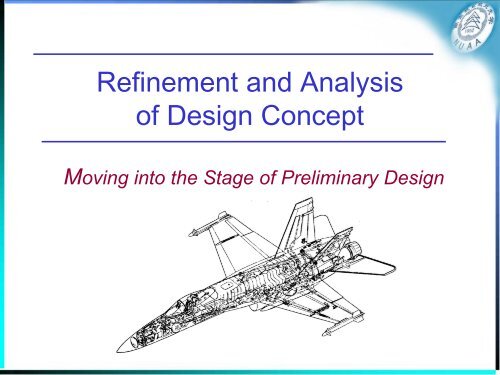





![Introduction to RF Stealth [Book Review] - Antennas and ...](https://img.yumpu.com/16857890/1/190x245/introduction-to-rf-stealth-book-review-antennas-and-.jpg?quality=85)

